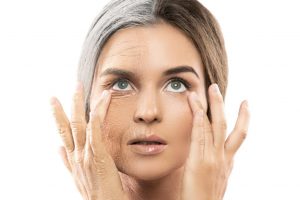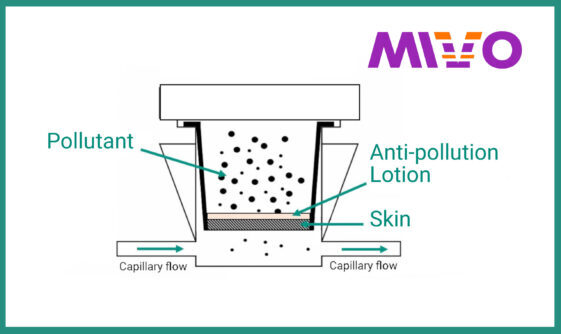Scientific research shows that polluting particles are extremely fine and highly dangerous. Our test allows to quantify the percentage of particulate passes through the skin model to determine the protective factor of the cosmetic compound. We call it “antipollution test”: it is fast, innovative and effective.
Air pollution can cause serious health problems, especially when the exposure to certain pollutants occurs for a prolonged period of time. According to the World Health Organization, the concentration of pollutants in the air significantly exceeds the recommended limits, and it is the cause of millions of deaths worldwide – https://www.who.int/airpollution/ambient/health-impacts /en/, while EPA (Environmental Protection Agency), argues that air pollution consists mainly of fine particles and gases (VOCs, volatile organic components). Urban dust is therefore a complex and heterogeneous mixture of pollutants including particulate matter and volatile organic compounds emitted from automobile and industrial exhausts, heavy metals and cigarette smoke.
In response to these occurences there are an increasing number of studies focused on researching the harmful effects that air pollution may have on the skin, which is the first barrier against external aggressions such as the pollution. To date, it is not yet clear what is the real impact of the exposure to pollutants on the skin, however, the market for anti-pollution cosmetic products is growing rapidly, as is the need to test the effectiveness of these solutions.
The effects of pollutants on human skin can occur in the short or long term, depending on the exposure time and the dose.
The short-term effects include phenomena such as the accumulation of toxins on the skin, its irritation or inflammation, obstruction of the pores, dryness, excessive peeling, alteration of the metabolism of proteins and lipids. Among the long-term effects, the most evident is premature skin aging, as several studies have shown [Schikowski, Tamara, and Anke Hüls. “Air pollution and skin aging.” Current Environmental Health Reports (2020): 1-7.]: particulate matter seems to accelerate the formation of wrinkles according to what could be an activation mechanism of the enzymes that initiate and increase the collagen degradation process. Particulate matter could also be the cause of impurities, acne, allergies, age spots, and even skin cancer. Evidences have also been reported that link the particulate matter to the formation of dark circles around the eye, the sagging of the eyebrows, the thinning of the lips, the formation of spots due to toxins trapped in the pores. However, some of these hypotheses need to be scientifically validated with further studies.
The main problem, according to the unanimous opinion of scientists, is the formation of free radicals and the oxidative stress in skin cells, which is dramatically increased by pollution [Curpen S et al. A novel method for evaluating the effect of pollution on the human skin under controlled conditions, Skin Res Technol. 2020 Jan; 26 (1): 50-60].
The growing interest of cosmetic industry in anti-pollution has led to the exploration of new ingredients for the marketing of new products for detoxification, rebalancing and skin protection.
To test the effectiveness of an anti-pollution product, it is necessary to know which characteristics and functions of the skin tissue could be altered by pollutants. Recent studies [Lefebvre, M ‐ A., Et al. “Evaluation of the impact of urban pollution on the quality of skin: a multicentre study in Mexico.” International journal of cosmetic science 37.3 (2015): 329-338.] have identified some biomarkers that increase, in a relatively short time, if treated with pollutants, such as pH, lactic acid content, sebum production and secretion, levels of cellular oxidative stress, oxidation of proteins, DNA damage, etc … On the contrary, there are some biomarkers that undergo an under-regulation, such as the vitamin E content, and the skin lipid level (triglycerides, wax esters, free fatty acids, etc. ..). Some bio-markers, on the other hand, may increase or decrease depending on the pollutant used, such as the activity of antioxidant and detoxifying enzymes, the content of elastin and collagen, or the concentration of adenosine triphosphate (ATP).
All these bio-markers can be used for evaluating the effectiveness of an anti-pollution product or formulation. However, while it is widely accepted that pollutants are harmful to the skin, it is not well known what kind of pollutants (or their combinations) cause which skin alteration: there is currently no agreement on which bio-markers are more suitable for reliably testing the effectiveness of a product. Therefore, the best strategy is to test the new anti-pollution product for its effectiveness in blocking the passage of the pollutants through the skin barrier.
React4life has developed an in vitro test to assay the penetration of certified commercial particles, which recreate the atmospheric pollution, through customized membranes, that mimic the epidermis of the skin.
There are different strategies for performing skin penetration tests for the evaluation of the efficacy of anti-pollution products, both in vitro and in vivo: however, as generally accepted standard methods do not exist, most of them are unreliable, poorly reproducible or not enough sensitive for certain types of pollutants.
The innovative method patented by React4life is, on the contrary, reliable, reproducible, sensitive, easy to be implement, and allows the in vitro quantification of the percentage of particulates that penetrate through the skin and the evaluation of protection offered by the cosmetic compound https: // www. react4life.com/services/cosmetic-dermatology/antipollution-test/.
This method is based on the use of the MIVO® fluidic device (Multi In-Vitro Organ) which is able to host different human skin tissues (cell monolayers, reconstituted 3D tissues) and to imitate their physiological environment supporting the continuous perfusion of the epithelial tissue. Using this system, it is possible to quantify the percentage of particulate matter passed through the skin model, absorbed by the tissue, and not penetrated, both in the treated and control samples, for the determination of the protective factor of the cosmetic ingredient.



